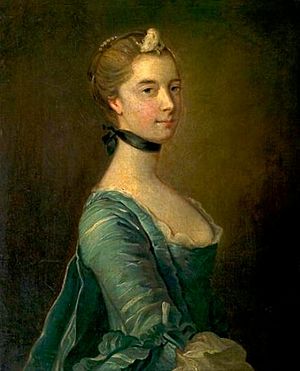Clementina Walkinshaw facts for kids
Quick facts for kids
Clementina Walkinshaw
|
|
|---|---|

Portrait by Allan Ramsay
|
|
| Born | 1720 |
| Died | 27 November 1802 Switzerland
|
| Nationality | Scottish |
| Known for | Mistress of Prince Charles Edward Stuart |
| Title | Countess of Albestroff |
| Children | Charlotte Stuart, Duchess of Albany |
| Parent(s) | John Walkinshaw Katherine Paterson |
Clementina Maria Sophia Walkinshaw (1720 – 27 November 1802) was a Scottish woman known for her relationship with Prince Charles Edward Stuart. He was also known as Bonnie Prince Charlie. Clementina and the Prince lived together for eight years. They had a daughter named Charlotte, who was born in 1753.
In 1760, the Prince's father helped Clementina and Charlotte move to a convent. He also provided them with money. After his death, Charles's brother, Cardinal Stuart, gave them an allowance. Charlotte was officially recognized by her father in 1783. She then joined him in Florence and took care of him until he died. Charlotte passed away in 1789. She left Clementina money and a yearly payment. Clementina raised her three grandchildren and lived in Switzerland in her later years. She passed away in 1802.
Contents
Early Life and Family
Clementina was the youngest of ten daughters. Her parents were John Walkinshaw of Barrowfield and Katherine Paterson. Her family, the Walkinshaws, were important people from Lanarkshire, Scotland. They owned lands like Barrowfield and Camlachie. Her father was a rich merchant from Glasgow.
Clementina's father was a strong supporter of the Jacobite cause. This meant he supported the Stuart family's claim to the British throne. He fought for James Francis Edward Stuart in a rebellion in 1715. He was captured but managed to escape to Europe. Clementina grew up in Rome, Italy. She might have been born there. It is believed she knew Prince Charles from a young age. She was even said to be the goddaughter of his mother, Clementina Sobieska. Clementina was educated in Europe and later became a Roman Catholic. In 1746, she was living at her uncle's home near Stirling, Scotland.
Life with Prince Charles Stuart
After Prince Charles's defeat at the Battle of Culloden in 1746, he fled Scotland. In 1752, he heard that Clementina was in Dunkirk and needed help with money. He sent her money and asked her to join him in Ghent. They later moved to Liège. Their only child, Charlotte, was born there on October 29, 1753. She was baptized as a Roman Catholic.
Their relationship became very difficult. By 1760, they were living in Basel. Clementina was tired of their unsettled life. She reached out to Prince Charles's father, James Francis Edward Stuart. He was also known as 'the Old Pretender'. Clementina wanted Charlotte to have a Catholic education. She also wanted to live in a convent. James agreed to give her money each year. In July 1760, he helped Clementina and seven-year-old Charlotte escape from Prince Charles. They went to a convent in Paris. Clementina left a letter for Charles. In it, she said she still cared for him but had to leave for her safety. Prince Charles was very angry. He tried to find them, but he could not.
Raising Her Daughter
For the next twelve years, Clementina and Charlotte lived in different convents in France. They were supported by the money James Stuart had promised. Prince Charles never forgave Clementina for taking their daughter. He refused to give them any money. James died in 1766. Prince Charles still would not help them. Clementina, who now called herself the Countess of Albestroff, had to ask his brother, Cardinal Henry Stuart, for help.
Cardinal Henry gave them a smaller amount of money. In return, he made Clementina sign a paper. This paper stated that she had never been married to Charles. She later tried to say this was not true. Because they had less money, they had to find cheaper places to live.
In late 1772, Clementina and Charlotte traveled to Rome. They hoped to get help in person. This trip put Clementina even more in debt. Prince Charles was angry when they arrived. He refused to see them. They had to return to France. Charlotte continued to send him letters from there, asking for help.
Later Years
In 1783, Charlotte was finally recognized as Prince Charles's daughter. She was allowed to see her father. Charlotte needed money for herself and Clementina. So, she moved to Florence to live with her father and take care of him. Charlotte left her three children with Clementina to look after.
Charlotte died on November 17, 1789, at age 36. She had liver cancer. In her will, Charlotte stated that Clementina would receive a large sum of money and a yearly payment. However, Cardinal Henry Stuart controlled this money. He would only give it to Clementina if she signed a document. This document meant she gave up any future claims on the family's money for herself and her grandchildren.
Clementina Walkinshaw continued to care for her three grandchildren. She lived until 1802. In her later years, she lived in Switzerland. She raised her grandson, Roehenstart, in the Protestant faith. During the French Revolution, Roehenstart's father paid for his education in Germany. When Clementina died, she left Roehenstart a lot of money.
In Popular Culture
Clementina Walkinshaw appears as a small character in the novel Redgauntlet (1824) by Sir Walter Scott.
Scottish singer-songwriter Brian McNeill wrote a song about Clementina Walkinshaw. It is called "How the Foreign Winds Do Blaw." This song is on his album The Baltic tae Byzantium.



